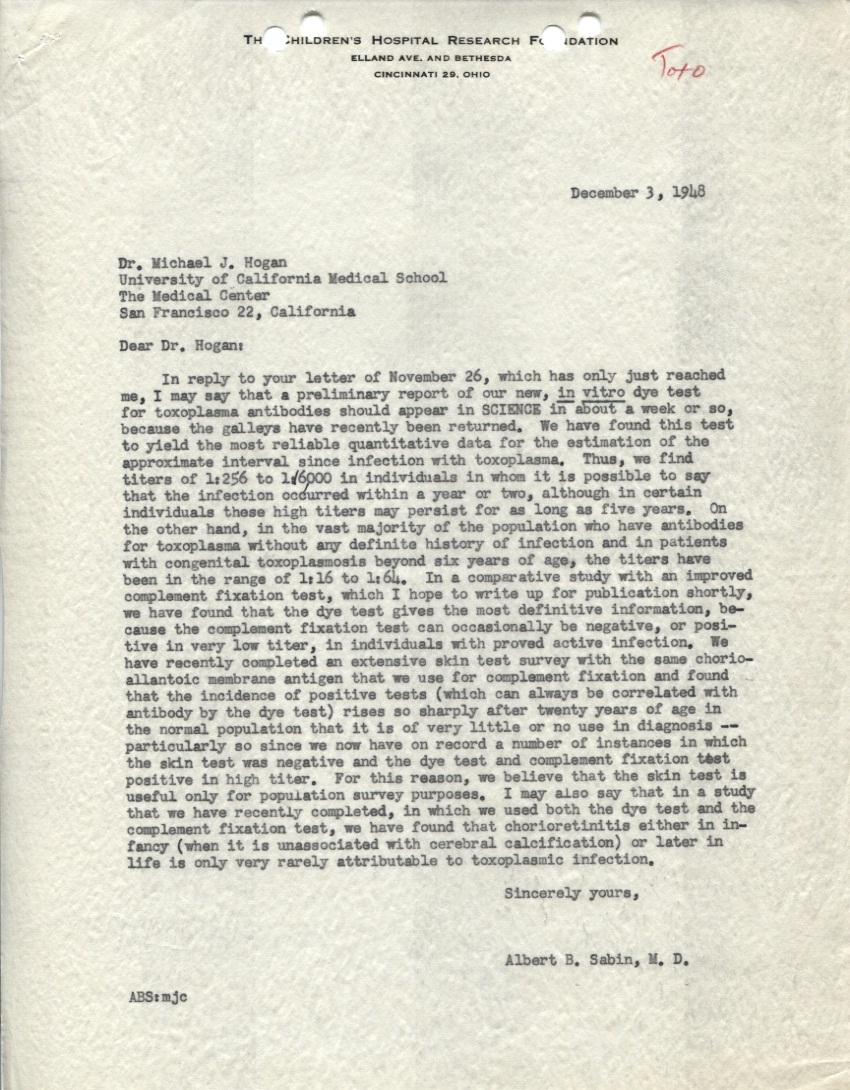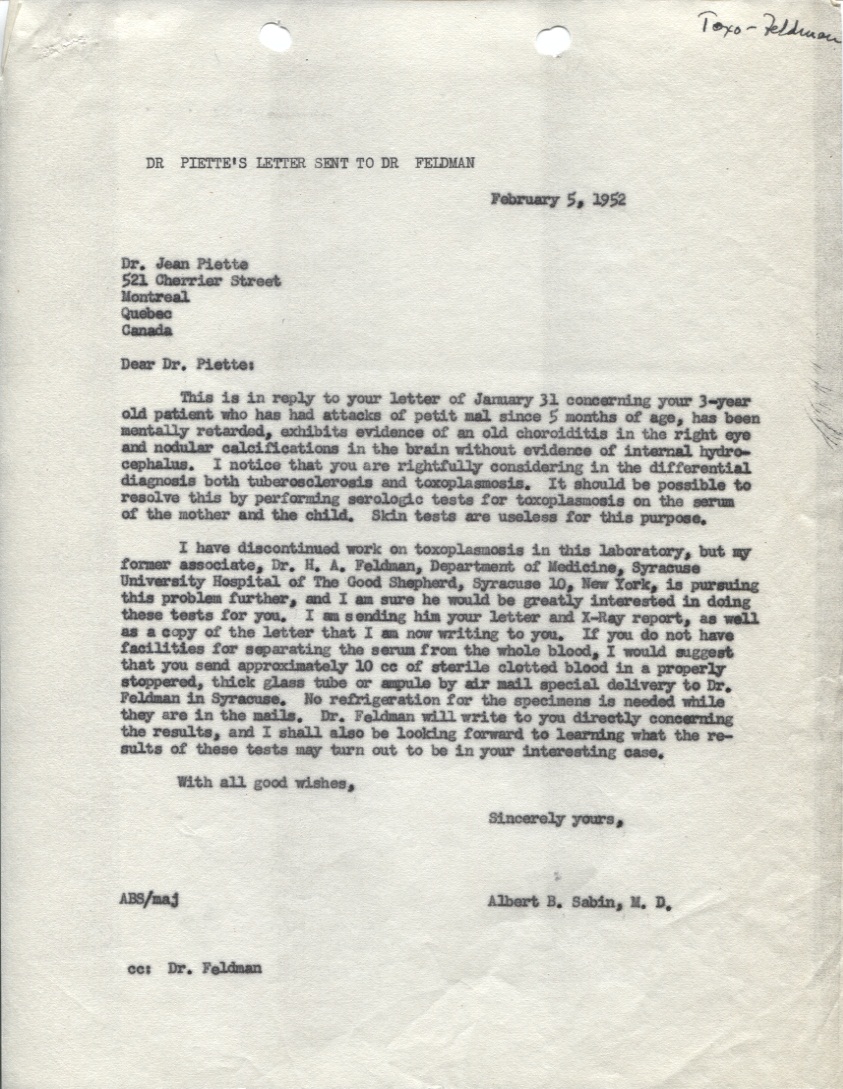Recently, I have been working with letters in the Sabin collection about toxoplasmosis, a disease that Dr. Sabin and several of his colleagues researched for quite some time. Some of this correspondence contains health information, so I have been reading letters quite closely to make sure we protect the privacy of those mentioned.
Here is some background information: Toxoplasmosis is a disease caused by the parasite Toxoplasma gondii and generally has few symptoms for those with healthy immune systems. However, those who are pregnant or have compromised immune systems are at risk for serious health problems if they are infected with Toxoplasma.[1] Many of the letters in the collection discuss congenital toxoplasmosis, which is when an unborn baby is infected with the parasite during the pregnancy, including labor and delivery. This infection can cause premature birth, as well as hearing loss, low birth weight, vision problems, seizures, and mental retardation. As you can imagine, mothers whose children were born with these types of symptoms were concerned for the health of the child, as well as concerned for their future children.
In 1948, Dr. Sabin and his colleague Dr. Harry A. Feldman published a brief paper in Science describing a Toxoplasma dye test, which often referred to as the Sabin-Feldman dye test (see note at end of blog for the citation). Today, this test is still recommended for use over other diagnostic methods.[2] Since I have recently examined correspondence about the disease and the dye test, I thought I would share some of the correspondence in our collection.
Dr. Sabin wrote to the editor of Science in July about the toxoplasmosis dye test manuscript saying, “While the paper may perhaps be a bit long for a preliminary communication in Science, the subject matter deals with an entirely new, hitherto undescribed phenomenon.”[3] However, Dr. Sabin probably should have said “unpublished” phenomenon, because he had described the dye test to numerous colleagues in his correspondence. One example is seen here.
In November, prior to the publication of the article, Dr. Michael Hogan from the University of California wrote Dr. Sabin asking for information on his “new diagnostic test” for toxoplasmosis that they had heard about from some men from Cincinnati who had recently attended a meeting of the American Academy of Ophthalmology and Otolaryngology. Dr. Hogan wasn’t the first to ask Dr. Sabin about this test either.
At the beginning of December, Dr. Sabin replied to Dr. Hogan about his new, in vitro dye test, saying, “We have found this test to yield the most reliable quantitative data for the estimation of the approximate interval since infection with toxoplasma.” He went on to compare the dye test to the complement fixation test that was currently being used by other researchers, “We have found that the dye test give the most definitive information, because the complement fixation test can occasionally be negative, or positive in very low titer, in individuals with proved active infection.”[4]
Shortly after the publication of the article, Dr. Sabin’s lab discontinued its work on toxoplasmosis to focus on researching other diseases (mainly polio.) However, his co-author Dr. Feldman continued to research the disease and in his new lab at Syracuse University. For many years afterward, Dr. Sabin would receive specimens that physicians would want him to test for toxoplasmosis, and he would send the materials on to Dr. Feldman at Syracuse University, and later the State University of New York. As seen in this letter from 1952, Dr. Sabin referred Dr. Piette to Dr. Feldman for the serologic tests for toxoplasmosis. At the end, Dr. Sabin wrote, “I shall also be looking forward to learning what the results of these tests may turn out to be in your interesting case.”[5] As usual, Dr. Sabin was a curious man, taking interest in cases even though he was no longer researching toxoplasmosis.
For more information about Dr. Feldman, please visit the SUNY Upstate Medical University’s Health Science Library website.
References
Note: The citation for the article on the Toxoplasma dye test is Sabin, Albert B. and Harry A. Feldman. “Dyes as Microchemical Indicators of a New Immunity Phenomenon Affecting a Protozoon Parasite (Toxoplasma).” Science 108 (1948): 660-663.
[1] Centers for Disease Control and Prevention, “Toxoplasmosis Frequently Asked Questions.” http://www.cdc.gov/parasites/toxoplasmosis/gen_info/faqs.html.
[2] For more information, see articles such as Udonsom, R., et. al. “Is Sabin-Feldman dye test using T. gondii tachyzoites from animal inoculation still the best method for detecting Toxoplasma gondii antibodies?” Southeast Asian Journal of Tropical Medicine and Public Health 41 (2010): 1059-64 and Reiter-Owona, I., et. al. “The Past and Present Role of the Sabin-Feldman Dye Test in the Serodiagnosis of Toxoplasmosis.” Bulletin of the World Health Organization 77 (1999): 929-935.
[3] Letter from Dr. Sabin to the Editor of Science, 2 July 1948. Found in Series #3 – Manuscripts, Box #8, Folder #4 – “Dyes as microchemical indicators…”
[4] Both Dr. Sabin and Dr. Hogan’s letters can be found in Series #8 – Other Diseases Researched, Sub-series Toxoplasmosis, Box #4, Folder #11 – Miscellaneous, July-December 1948.
[5] Letter from Dr. Sabin to Dr. Piette, 5 February 1952. Found in Series #8 – Other Diseases Researched, Sub-series Toxoplasmosis, Box #5, Folder #7 – Feldman, Harry A., 1952.
In 2010, the University of Cincinnati Libraries received a $314,258 grant from the National Endowment for the Humanities (NEH) to digitize the correspondence and photographs of Dr. Albert B. Sabin. This digitization project has been designated a NEH “We the People” project, an initiative to encourage and strengthen the teaching, study, and understanding of American history and culture through the support of projects that explore significant events and themes in our nation’s history and culture and that advance knowledge of the principles that define America. Any views, findings, conclusions, or recommendations expressed in this blog do not necessarily reflect those of the National Endowment for the Humanities.


